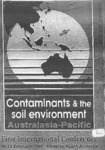Use este identificador para citar ou linkar para este item:
http://www.alice.cnptia.embrapa.br/alice/handle/doc/667511Registro completo de metadados
| Campo DC | Valor | Idioma |
|---|---|---|
| dc.contributor.author | CRAVO, M. da S. | pt_BR |
| dc.contributor.author | MURAOKA, T. | pt_BR |
| dc.date.accessioned | 2015-01-10T08:04:38Z | - |
| dc.date.available | 2015-01-10T08:04:38Z | - |
| dc.date.created | 1997-09-18 | pt_BR |
| dc.date.issued | 1996 | pt_BR |
| dc.identifier.citation | In: INTERNATIONAL CONFERENCE CONTAMINANTS AND THE SOIL ENVIRONMENT, 1., 1996, Adelaide. Extended abstracts... p. 53-54. | pt_BR |
| dc.identifier.uri | http://www.alice.cnptia.embrapa.br/alice/handle/doc/667511 | pt_BR |
| dc.description | The objective of this research was to verify the effects of increasing rate of applications of two town solid waste composts to two Brazilian soils on various heavy metal contents in plant available forms. Second the results, the increase in soil available heavy metal contents with increase in compost rate application, is of great concern when high doses of composts are used in agriculture, and this suggests the need of a redefinition of the permitted maximum rate of waste compost application, in order to avoid causing risk to human health. | pt_BR |
| dc.language.iso | eng | eng |
| dc.rights | openAccess | eng |
| dc.subject | Brasil | pt_BR |
| dc.subject | Sao Paulo | pt_BR |
| dc.subject | Manuring | pt_BR |
| dc.subject | Residues | pt_BR |
| dc.title | Heavy metal contents of two Brazilian Oxisols treated with urban waste composts. | pt_BR |
| dc.type | Artigo em anais e proceedings | pt_BR |
| dc.date.updated | 2015-01-10T08:04:38Z | pt_BR |
| dc.subject.thesagro | Adubação | pt_BR |
| dc.subject.thesagro | Agricultura | pt_BR |
| dc.subject.thesagro | Resíduo | pt_BR |
| dc.subject.nalthesaurus | agriculture | pt_BR |
| dc.subject.nalthesaurus | waste utilization | pt_BR |
| riaa.ainfo.id | 667511 | pt_BR |
| riaa.ainfo.lastupdate | 2015-01-09 | pt_BR |
| dc.contributor.institution | Embrapa Amazonia Ocidental; ESALQ. | pt_BR |
| Aparece nas coleções: | Artigo em anais de congresso (CPAA)  | |
Arquivos associados a este item:
| Arquivo | Descrição | Tamanho | Formato | |
|---|---|---|---|---|
| hhh.pdf | 3.6 MB | Adobe PDF |  Visualizar/Abrir |









